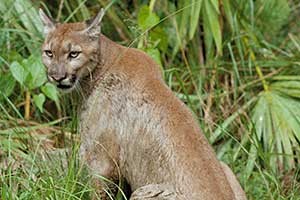Because the only natural predators of Florida panthers are American alligators and American crocodiles, the drastic decline in Florida panther populations can be blamed almost entirely on human encroachment. Southwest Florida is one of the fastest developing areas in all of the United States, and the addition of major roads and housing communities within prime panther habitats has been an issue of controversy in the area for some time. When you consider that one of the leading causes of death amongst Florida panthers is automobile collisions, it is obvious that this construction is having a major impact. What is less obvious is the fact that roadways also separate male and female panthers from each other and prevent breeding. Recent studies have shown that the great majority of panthers hit on the road are male and that females tend to be more reluctant about crossing roads in general, offering them protection from accidents but unfortunately also separating them from the males and inhibiting the future growth of their species.
In addition to roadside collisions, the other leading cause of death amongst Florida panthers is territorial disputes between panthers. While this aggression has always naturally existed between panthers, it becomes much more of a danger when panthers are limited to smaller areas, a natural result as more and more of their prime habitats are destroyed to make way for more humans. In addition to the territorial disputes that arise in such close quarters, Florida panthers are also heavily prone to inbreeding. In fact, of all puma species, the Florida panther has the lowest genetic diversity, and inbreeding leads to such complications in individuals as cardiac defects and weakened immune systems, further lowering the survival chances of those who manage to pass infancy.
Furthermore, in addition to the threats previously mentioned, because of their weakened immune systems Florida panthers are also more susceptible to certain diseases, such as feline immunodeficiency virus and feline leukemia virus. Pollution in and around their environments has also exposed Florida panthers to harmful chemicals, chemicals which further inhibit their reproduction. In some cases, tests have even shown that male Florida panthers have the ability to become feminized after certain levels of chemical exposure. Unfortunately, what you end up with is a feminized male, who because he thinks of himself as female, is highly unlikely to then reproduce with the true females around him.
Despite the rareness of an encounter with a Florida panther, these beautiful and large cats can still be occasionally observed in South Florida, though more and more instances of sightings are occurring around homes or public parks, places where it is more than likely that a lost panther just happened to wander into a zone inhabited by humans. To take your chances of spotting a Florida panther for yourself in the wild, you can always try a trip on a local airboat tour, where much of the local Everglades wildlife can be viewed from a safe distance. Everglades tours are a great opportunity to not only observe an abundance of animals and plants unique to the area, but you will also step off the boat with a newfound appreciation for the native species that call this area home and a greater understanding of why exactly these animals need to be saved and protected.







